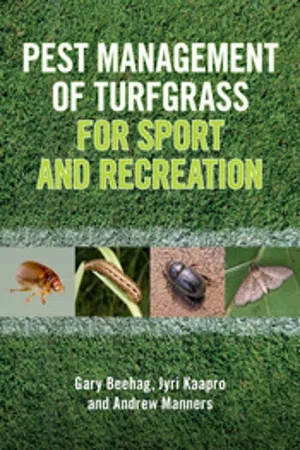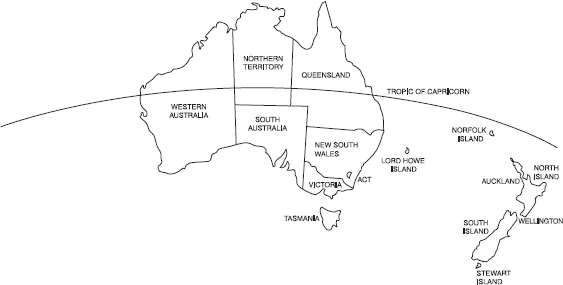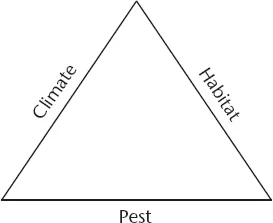![]()
1
Dynamic world of turfgrass pests
Introduction
Turfgrass provides a wide range of aesthetic, recreational and environmental benefits. Appearing uniform at the surface, turfgrass swards form dynamic ecosystems with numerous plants, animals, fungi and microorganisms. Like all cultivated plants produced in a monoculture, turfgrass has long been associated with pests. Some pests may simply be a nuisance, others may cause serious harm or damage. Typical turfgrass pests include unwanted plants (weeds), disease-causing microorganisms (plant pathogens) and herbivorous insects and mites. This book focuses on the insect and mite fauna that inhabit and damage turfgrass in Australia and NZ (Fig. 1.1). In the context of this book, ‘pests’ refer to herbivorous insects and mites.
Perennial grasses are the most common plant species managed as turfgrass. However, non-grass plants or prostrate, flowering forbs are sometimes used in certain instances. Here, the term ‘turfgrass’ describes all grass (annual and perennial) and non-grass (flowering forb) plant species subject to a mowing regime. The botanical names of certain plants used throughout the book are provided in Appendix 1, if they are not provided in the text. Most notably, ‘couchgrass’ always refers to Cynodon dactylon.
There are numerous books and technical information concerning turfgrass insect and mite pest management in the northern hemisphere. However, the majority of northern hemisphere pests are either uncommon or absent in Australia and NZ. Conversely, numerous species of herbivorous insects and mites are unique to the southern hemisphere. Varieties of turfgrass present in Australia and NZ are often different from those of the rest of the world. Furthermore, many options for the management of herbivorous insects and mites in the northern hemisphere are not currently available in Australia or NZ.
Fig. 1.1: Map of Australia and NZ showing states, territories and capital cities.
This book assists Australian and NZ turfgrass managers by aggregating relevant information, and information that is otherwise difficult to obtain. Unfortunately, relatively little research effort has been devoted to turfgrass pests and their management in Australia and NZ. As a consequence, there are some gaps in knowledge about certain details of the biology and ecology of many insects and mites that damage turfgrass. The book offers a compilation of known biology, ecology and successful management practices for Australian and NZ conditions and summarises practical advice on pest identification and management. This information will benefit bowling greenkeepers, golf course superintendents, racecourse managers, sportsground curators, turfgrass producers and lawn maintenance personnel.
Modern turfgrass pest management includes an expanding armoury of cultural, biological and chemical management technologies. It is hoped that this book will reduce errors in turfgrass pest management. Inappropriate measures can result in poor control of the target pest, resurgence of secondary pests, death of beneficial organisms and sometimes even death of the turfgrass itself.
Structure of this book
There are two main aims of this book. The first is to enable readers to identify insect and mite pests, natural enemies and benign organisms commonly found in turfgrass environments. Many turfgrass managers are able to recognise commonly observed insects; however, new organisms may cause some consternation as to whether they are beneficial or harmful insects. Understanding the basic morphology (appearance) of insects and mites can assist turfgrass managers to recognise and categorise the organisms encountered. For this reason, Chapter 2 provides a basic foundation on the physical attributes of insects and mites that are important for distinguishing different groups. Further information in the remainder of the book will help readers to identify and manage the organism.
The second aim of this book is to assist turfgrass managers to develop a personalised pest management plan within an integrated pest management (IPM) framework. While there are many views on what IPM entails, the perspective taken in this book is that IPM simply uses all available methods strategically to produce a sward in the most cost-effective way possible. In other words, IPM includes the use of cultural practices, pesticides and biological control.
The cornerstone of pest management is knowing what pests and beneficial organisms are present. The only way to achieve this is through regular monitoring. Hence, Chapter 3 is devoted to describing how to monitor insects and mites in turfgrass. Developing a pest management plan does not have to be complicated or difficult. At first, all known information is used to formulate a working plan that can then be modified over time. There are many strategies that can be used within such a plan, and Chapter 4 describes these concepts. Chapter 4 also provides guidelines on how to create a personalised pest management plan.
Available information on the biology and management of all turfgrass pests from Australia and NZ has been collated and organised by the part of the plant affected, i.e. roots, stems and leaves. Chapter 5 covers pests that damage roots, Chapter 6 discusses pests on stems and Chapter 7 focuses on pests on foliage. Some pests damage more than one part of the plant. In these cases, the pest is described in the chapter that covers the plant part that is most damaged, and a note in other relevant chapters refers the reader to the main description.
The most common approach for the control of turfgrass pests is the use of chemical pesticides. Active ingredients registered for each pest species are included in the management section for each species in Chapter 5–7. Pesticides (and biopesticides) will always be a component of an IPM program as they remain the only way to quickly reduce large populations. The strategic use of pesticides to manage insects and mites in a cost-effective manner is discussed in detail in Chapter 8. The inclusion of active ingredients and product names is not an endorsement by the authors. As a general rule, active ingredients are listed in preference to trade names. This has been done as there are many trade names for a single active ingredient, and trade names may change even if the active ingredient remains the same. In all cases, readers should refer to current label instructions before selecting and applying any product, to ensure that it is relevant for their exact situation.
While pesticides are important, many other methods can be employed to reduce population levels to the point where pesticides may not be required on a regular basis. Ultimately, it is hoped that turfgrass managers will benefit from strategies described in Chapter 4 and in the management section in each pest species in Chapters 5–7 such that pests are managed more cost-effectively and with reduced environmental impacts (including on human health).
Last, the biology of insects and mites involves many specific terms that may not be understood without formal training in biological and/or entomological sciences. In many cases, key concepts are described without using the specific terms used by entomologists. This was done to facilitate greater understanding of biological implications of the concepts for management of a pest, as opposed to teaching entomological terms. Where this was not possible, the meaning of the term is included in the glossary, located at the back of the book.
In the remainder of this chapter, underlying factors that influence the occurrence of damage by turfgrass pests are discussed. In addition, the effects of climate change on turfgrass pests are briefly outlined.
Pest triangle: climate, habitat/turfgrass and pest species
All species and cultivars of turfgrass can be damaged by pests. Three factors significantly influence whether any given turfgrass pest will cause economic loss or significant damage: (1) climatic conditions must be favourable for the survival of the pest, (2) cultural management practices of the turfgrass must be amenable to the survival of the pest, and (3) the pest must be primarily adapted to the turfgrass species/variety present. The distribution of all herbivorous insects and mites is largely determined by these three variables (Fig. 1.2).
Fig. 1.2: Factors influencing the presence of insect and mite pests.
The climate factor
Like all organisms, insects and mites are adapted to a set of environmental conditions. If these conditions are not met, they cannot survive and populations will never reach damaging levels. Populations are strongly influenced by regional and seasonal weather patterns. The size of the pest population is directly related to how well climatic conditions meet the requirements of a species, assuming other conditions are also met. The principal climatic factors that determine geographical limits of insects and mites are temperature, moisture, wind and light (Fig. 1.3).
Ambient temperature, normally from solar radiation, is the principal driving force behind insect and mite growth, development and behaviour. Higher temperatures are generally associated with faster lifecycles. All insect and mite species thrive within a preferred temperature range; temperatures above or below this range result in inactivity, diapause or death. The exact temperature range is dependent on the species. Insects and mites cannot directly control their body temperature. Being cold-blooded, the behaviour of individuals plays an important role in their body temperature. For example, on hot days many insects will move into shaded areas or move further underground (if subterrane...


